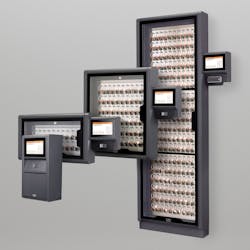Unlocking Data Center Security: The Power of Integrated Key Management
The Hidden Risks of Mismanaged Keys
Data centers, despite their leading-edge technology and stringent security protocols, often face significant risks due to inadequate key management. Lost or misplaced keys can lead to potential security breaches, while inefficient key processes result in operational delays and increased costs.
"If a master key or highly sensitive key goes missing, the cost to rekey a part of a data center or a whole facility might be in the thousands — or even tens of thousands — of dollars," Newell warns. “This financial risk is compounded by the operational inefficiencies caused by time spent searching for keys or equipment. And, with missing keys, very real security threats also come into play.”
The lack of accountability for key usage introduces significant vulnerabilities in data center security. Without a clear record of who accessed what and when, maintaining proper control becomes extremely challenging. As the volume and value of data stored in these facilities continue to increase, so do the associated risks. Here's why effective key management is crucial:
-
Asset Value: Data centers house increasingly valuable IT equipment and infrastructure. As these facilities grow in size and complexity, the potential financial impact of theft, damage, or disruption escalates accordingly.
-
Cybersecurity Integration: While often overlooked, physical security is a critical component of overall cybersecurity. Preventing unauthorized physical access is essential to safeguarding sensitive data from theft, espionage, or destruction.
-
Regulatory Compliance: Stringent data protection regulations, such as the EU’s General Data Protection Regulation (GDPR) and the California Consumer Privacy Act (CCPA), necessitate robust physical security measures to protect customer data. Non-compliance can result in significant fines and reputational damage.
-
Evolving Threat Landscape: The increasing sophistication of threats, including both external and internal risks, underscores the need for advanced physical security systems to deter and mitigate potential breaches.
For these reasons, effective key management isn't merely an optional extra; it's a fundamental component of a comprehensive security strategy. It's essential for safeguarding data, ensuring regulatory compliance, and mitigating against a wide range of potential threats in the fast-evolving landscape of data center operations.
Comprehensive Asset Management
Measuring Impact and Future Trends
Implementing integrated key and asset management systems offers tangible benefits that translate directly to the bottom line. Beyond the obvious security enhancements, these systems drive significant operational efficiencies.
"Organizations incur a significant amount of downtime, perhaps more than people often realize, just looking for keys or assets," Newell points out. “By eliminating this wasted time and streamlining access to necessary keys and tools, data centers can see a rapid return on investment, often within a year.”
As data centers continue to proliferate and grow in complexity, the management of physical keys and assets remains a critical component of a comprehensive security strategy. Looking to the future, Newell envisions a transformative role for integrated key and asset management systems in data centers.
"The next wave of innovation will likely see these systems supporting multiple active credentials per user, including mobile and wearable technologies," he explains. "But that's just the beginning. As we move forward, I anticipate even greater integration and automation. They'll seamlessly interface with AI and machine learning technologies, predictively managing access based on real-time needs and risks, leading to enhanced security, optimized resources, and more efficient data center operations."
For more information, contact Traka at [email protected] or 877-348-7252.
Sponsored by:




